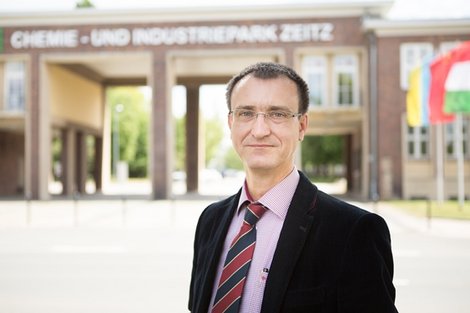A gigantic achievement

Zeitz Chemical and Industry Park is one of the biggest industry parks in Saxony-Anhalt. It rose from the remnants of a former hydrogenation works in 1996. It is operated by Infra-Zeitz Servicegesellschaft mbH. We met with its Managing Director, Arvid Friebe, and discussed the concept behind the park, its success, and the challenges for the future. Arvid Friebe is also the spokesman of the CeChemNet Association, the Central European Chemical Network.
Mr Friebe, you have been the Managing Director of Infra-Zeitz Servicegesellschaft mbH since 2013. How big is the chemical park that you oversee?
The chemical park is 232 hectares in size, which is equivalent to 300 football fields. It is home to 50 companies, 35 of which are service providers, ten of which are production operations, and five of which are energy producers. Almost 1,000 people are employed here, and the total turnover amounts to some 600 million Euros per year. In terms of the used volumes of cooling water and the volume of waste water, it is evident that production has increased since 2015. After the slump in 2008 due to the economic crisis and a period of three or four years of stagnation, things are on the up again. The world of business has learnt how to cope with the uncertainties.
What, exactly, is the basic concept behind Zeitz Chemical Park?
We have five key attributes. Firstly, the chemical park is open, which means it isn’t a closed compound, and apart from the disposal of wastewater, there are no compulsory services. Secondly, as a municipal company, we are independent, which means we do not have any specific interests in terms of our choice of supplier. Thirdly, we are strongly characterised by medium sized businesses. Fourthly, we are international, and half of the production operations here are foreign owned.
For example?
The wheat starch company Interstarch GmbH is owned by a company based in the Ukraine, the mechanical engineering firm ZEMAG is Chinese, the producer of base chemicals Radici Chimica is Italian, and the Puraglobe refinery, which processes used oil, is from the USA.
And what is the fifth attribute of the chemical park?
Its sustainability. Some 70 percent of the products here are manufactured from recycled raw materials or biomass. In the German chemicals industry as a whole, the latter has a percentage share of 13 to 14 percent, while here, it is 35 percent. In addition, forty percent of the energy that we use here comes from renewable energy sources in Saxony-Anhalt or Saxony.
Is any energy generated at the park itself?
Yes. The park is home to several photovoltaic plants, a biogas plant, and there are several cogeneration units and steam generators on the basis of CO2-neutral natural gas in operation.
This means that you must be well equipped for the energy transition.
We are now, yes. Initially, however, the energy transition put our business at considerable risk, because in our role as operators, we have to pay the full energy levy – the companies themselves are exempt. We had to find a solution in a very short time frame. If we had decided to pass the costs on to our customers on a permanent basis, the concept behind the chemical park would have been broken. If we had paid the costs ourselves, however, we would have become insolvent. The cogeneration plant that we decided to establish enables us to produce electricity autonomously and at low cost.
Is the chemical park full?
No, of the 190 hectares available for sale, 120 have so far been sold. I can’t make a definitive forecast, but I am confident that we will be full at some stage in the future.
The future compatibility and locational advantages of the chemical park have proven to be a success. Do you compete with the other chemical parks in Saxony-Anhalt?
The developments in this area have been positive. After the reunification, there were lots of brownfield sites awaiting development and lots of competition. Things have now become differentiated, and each chemical park has its own profile. I’d say that it’s an 80/20 split: 80 percent of the time we’re collaborating, and the remaining 20 percent, we’re competing.
What kind of the support have you received from the federal state of Saxony-Anhalt?
It has been excellent. The support from the investors has been superb – with the construction of the wastewater treatment facilities here, for instance. Over the years to come, Infra-Zeitz is to invest approximately 18 million Euros in the construction of a new facility, with the federal state contributing approximately 65 percent of the funding. The collaboration with the authorities has also been very good, a great example of which is our work with the Landesanstalt für Altlastenfreistellung (Regional Office for Brownfield Sites), which is responsible for cleaning up contaminated sites. The staff at the office are dedicated and professional and our cooperation with them has been straightforward and solution-based.
You are also the spokesman of the Central European Chemical Network, CeChemNet for short. It is a network which was founded in 1996 and encompasses five centres for chemicals, four of which come from Saxony-Anhalt. What is your goal?
We want to create a positive environment for the chemicals industry. We tell the world of politics about the current problems and issues in an open atmosphere. We want to be taken seriously and are very happy with the feedback we have received. We have good links with the political decision makers in the federal state – and also with the federal government. We hold regular meetings with the federal government’s Commissioner for Eastern German Affairs, Parliamentary Secretary Iris Gleicke. We want to raise the profile and further the interests of the chemical parks here and the industries to which they are home – after all, they are the second biggest generators of turnover in Saxony-Anhalt. We also want to strengthen our mutual exchanges so as to channel possible conflicts. Finally, we want to present ourselves to the outside world together – as a single unit.
What challenges are the worlds of politics and industry set to face in the future?
There are quite a few – and we have presented them to the political decision makers in the form of a list of demands. Here are some examples: firstly, streamlined rules surrounding the promotion of investment at every level, up to and including the EU. The power grid utilisation fees need to be made uniform at the federal level to nullify the disadvantageous position of the new federal states due to their high stock of renewable energy plants. It is also necessary for the operators of the chemical parks to be included in the compensation scheme for the levy according to the German Renewable Energy Act and the support of cogeneration plants. The logistics infrastructure is also a key topic, and the important routes between the chemical parks in eastern Germany need to be modernised and upgraded. Finally, we are increasingly facing a shortage of skilled workers and are demanding the inclusion of a course in “Business and Work” in the syllabi of secondary schools; we also want to see cooperation-based partnerships and an acceleration of the integration of foreign workers in the jobs market.
What is the current situation with regards to research?
The co-operation between the chemical industry and the corresponding facilities is currently outstanding. For example, Zeitz cooperates very closely with Merseburg University of Applied Sciences. If any research facilities or their departments were ever to be closed, it would be a considerable, irreplaceable loss.
What is your forecast for the future?
The chemical industry is set to go through a structural change that is to be taken very seriously: away from bulk goods and towards specialist products. The world of politics needs to support this process and to carefully nurture the chemical industry which has developed in eastern Germany since the fall of the Berlin wall! Although a lot remains to be done, over the past twenty years, the achievement here has quite simply been gigantic!
www.industriepark-zeitz.de
Interview: Anja Falgowski
> more about the Chemical and Plastics Industry Saxony-Anhalt





